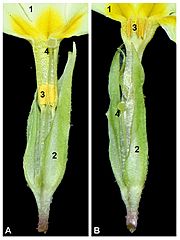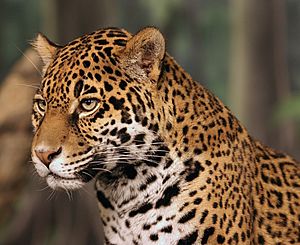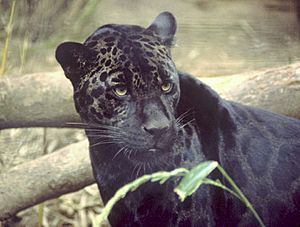Polymorphism facts for kids
Polymorphism in biology means that two or more clearly different forms exist within the same group of a species. These different forms are sometimes called morphs.
Polymorphism is very common in nature. A well-known example is sexual dimorphism, where males and females of a species look very different. Think of peacocks, where the male has a huge, colorful tail and the female does not. Another example is sickle-cell anaemia in humans.
For something to be called polymorphism, these different forms must live in the same place at the same time. They must also be part of a group where individuals can mate with each other randomly.
Contents
How Different Forms Appear
The way an individual gets one of these different forms is controlled by something called a switch. This switch can be in the genes, or it can be caused by the environment.
For example, in humans, whether you are male or female is decided by your genes (the XY sex determination system). But in some animals, like alligators, the temperature of the eggs during development decides if the baby will be male or female.
In social insects like ants, bees, and wasps, the sex of an individual is determined by whether the egg is fertilized or not. Females are diploid (have two sets of chromosomes), while males are haploid (have one set). Also, for ants, whether a larva grows into a worker or a guard ant depends on what it eats.
When the environment causes these different forms, it's called polyphenism. This system allows for more flexibility because the environment can change. However, environmental triggers are less common than genetic ones.
Genetic Polymorphism
While all polymorphism has a genetic basis, genetic polymorphism has a special meaning. It means:
- Two or more distinct forms exist at the same time and place.
- The rarest form is not just appearing because of new mutations. Instead, it's kept in the population by some kind of natural selection.
This definition has three key parts:
- The different forms belong to one group that can interbreed.
- The forms are clearly separate and distinct.
- The forms are actively kept in the population, not just appearing by chance mutations.
Genetic polymorphism is actively and steadily maintained in populations by natural selection. This is different from transient polymorphisms, where one form is slowly being replaced by another.
Genetic polymorphism means there's a balance or equilibrium between the different forms. The ways this balance is kept are called types of balancing selection.
What Keeps the Balance?
Several things can help keep different forms balanced in a population:
- Heterozygote Advantage: Sometimes, having two different versions of a gene (being a heterozygote) makes an individual stronger or more likely to survive than having two identical versions (being a homozygote).
- Frequency-Dependent Selection: The success of a certain form depends on how common it is compared to other forms. For example, if a certain prey animal has a rare color, predators might not be used to seeing it. This makes the rare form safer than the common ones.
- Changing Environments: What makes an individual successful can change over time or in different parts of a habitat. A form that is good in one situation might not be good in another.
- Group Interactions: The success of an individual's genes can depend on what other individuals in the population are doing. This covers many situations where survival depends on the actions of others in the group.
Examples of Polymorphism
Humans
Sickle-Cell Anaemia
A clear example of balancing selection is sickle-cell anaemia. This condition is mostly found in tropical areas like Africa and India.
People who inherit two copies of the gene for sickle haemoglobin (HgbS) have a serious illness and a short life. People with two copies of the normal haemoglobin gene (HgbA) are healthy. However, people who inherit one copy of the normal gene and one copy of the sickle gene (the heterozygote) are also generally healthy.
The sickle-cell gene survives in these populations because people with one copy of the sickle gene are resistant to malaria. The malarial parasite kills many people each year.
This is an example of heterozygote advantage. There is strong selection against people with two sickle genes. But there is also selection against people with two normal genes because they can get malaria. The heterozygote has an advantage as long as malaria exists. Because the heterozygote survives and thrives, the HgbS allele (gene version) stays in the population at a much higher rate than if it only appeared through mutation.
Lactase Persistence
Most Mammals, including humans, usually stop producing the enzyme lactase after they are babies and stop drinking their mother's milk. Lactase helps digest the sugar in milk.
However, many modern humans can drink milk throughout their adult lives. This ability is due to a mutation that keeps the lactase enzyme working. This mutation is common in human groups where milk has been an important part of their diet for a long time. Being able to digest milk helps people survive where milk is available.
Studies show that the mutations allowing adult milk digestion only became common in human populations in the last ten thousand years. This makes lactase persistence a good example of recent human evolution. Since the ability to digest milk is genetic, but raising animals for milk is a cultural practice, this is an example of gene–culture coevolution.
Ants
Ants show many different forms. First, their sex determination system is haplodiploid. This means all males are haploid (have one set of chromosomes), and all females are diploid (have two sets).
Second, different ant forms are mostly created by how the larvae are fed. This feeding determines, for example, whether an adult ant can reproduce.
Finally, there are differences in size and jobs (especially for females). These are usually controlled by feeding or age, but sometimes by genes. So, ants show both genetic polymorphism and extensive polyphenism.
Heterostyly in Flowers

An example of genetic polymorphism in plants is heterostyly. This is when flowers of the same species come in different forms with different arrangements of their pistils (the female part) and stamens (the male part).
A good example is the Primula flower, like P. vulgaris. There are two types of these flowers:
- The pin flower has a long style (the stalk of the pistil) with the stigma (the part that receives pollen) at the top. Its stamens are halfway down the flower tube.
- The thrum flower has a short style, so its stigma is halfway down the tube. Its stamens are at the top, near the opening.
This setup helps with pollination. When an insect searches for nectar in a long-style (pin) flower, pollen from the stamens sticks to a specific part of its body. When that same insect visits a short-style (thrum) flower, that pollen will touch the stigma of the thrum flower. The same happens in reverse.
Another important thing about heterostyly is that pollen from a pin flower usually cannot fertilize a pin flower, and thrum pollen cannot fertilize a thrum flower. This forces the plant to cross-pollinate with a different type of flower, which helps keep the genes mixed. Scientists know a lot about the genes behind this system; they act like a single unit called a super-gene.
Most species in the Primula group have heterostyly, showing that this system is very old. Charles Darwin also found this kind of structure in other plants like flax and Purple Loosestrife. Heterostyly is known in at least 51 different groups of flowering plants.
Drosophila Flies
Studies over many years have shown that wild populations of Drosophila (fruit flies) have different forms of their chromosomes. These differences are so common that natural selection must be actively keeping them in the population.
Related pages
See also
 In Spanish: Polimorfismo para niños
In Spanish: Polimorfismo para niños




